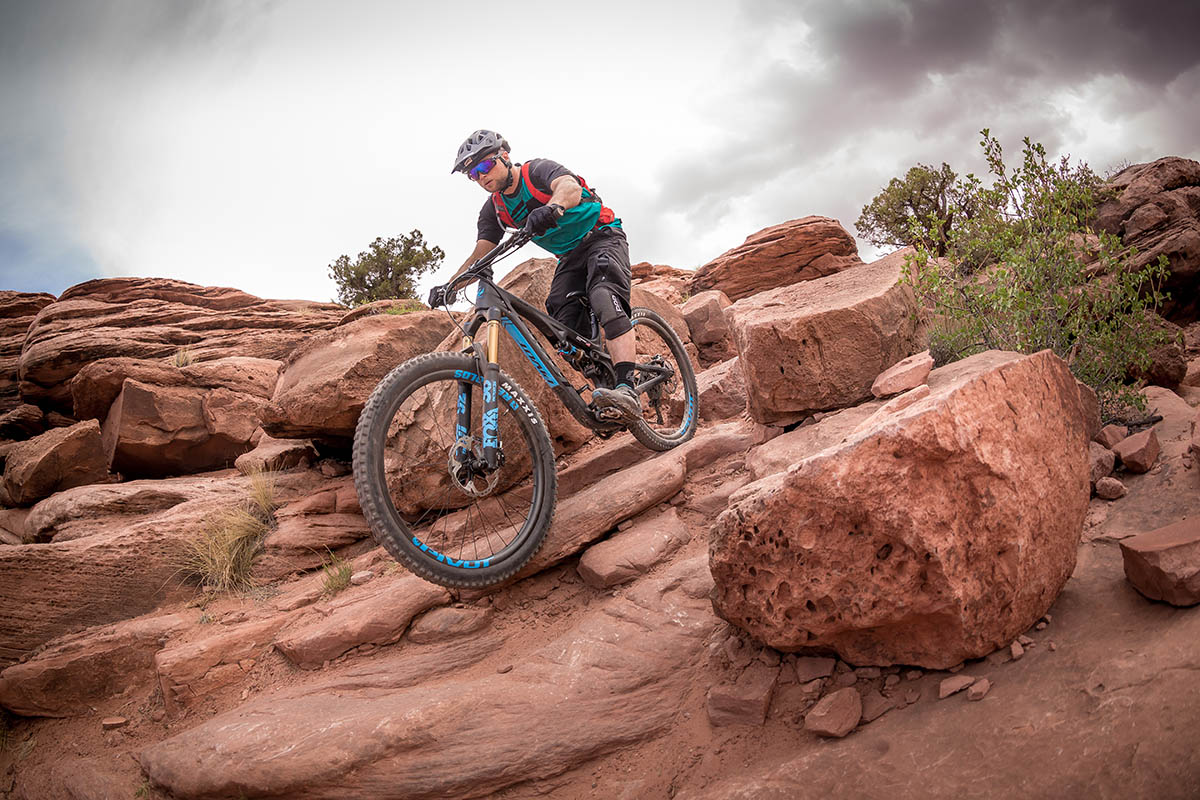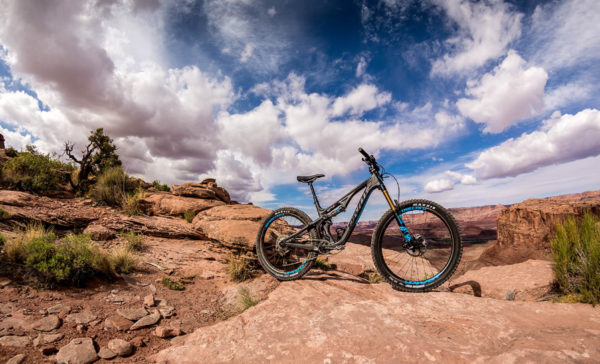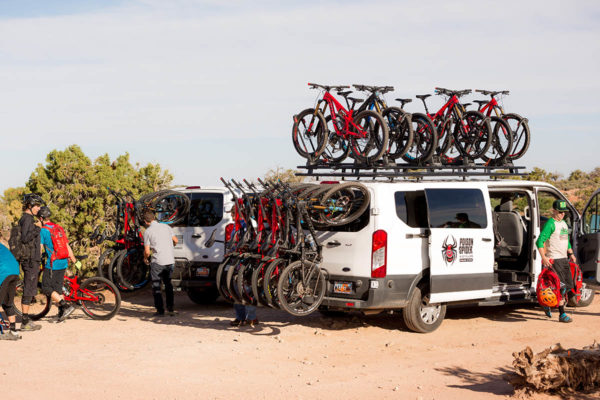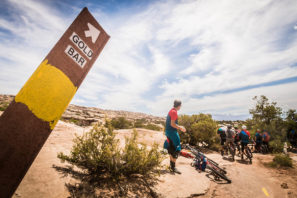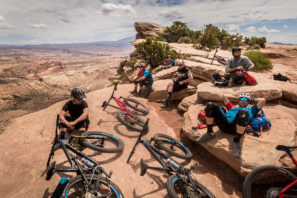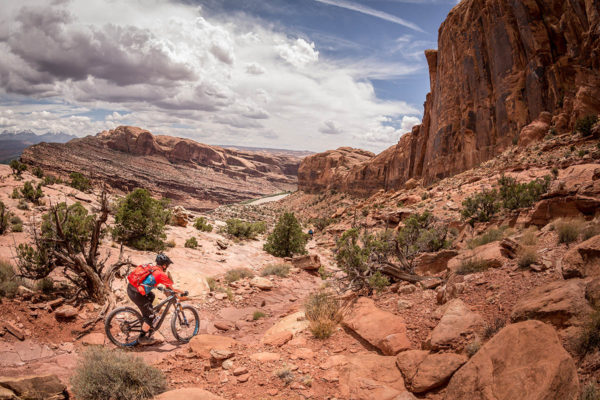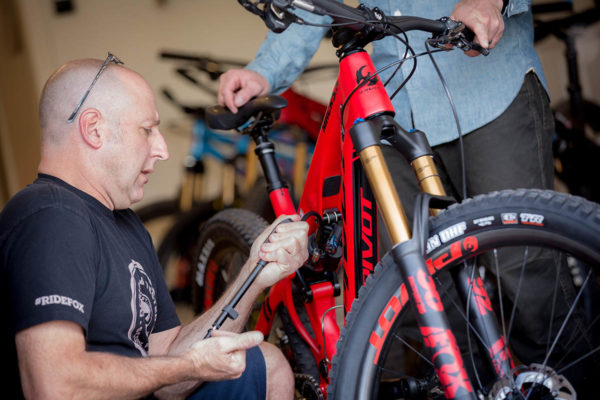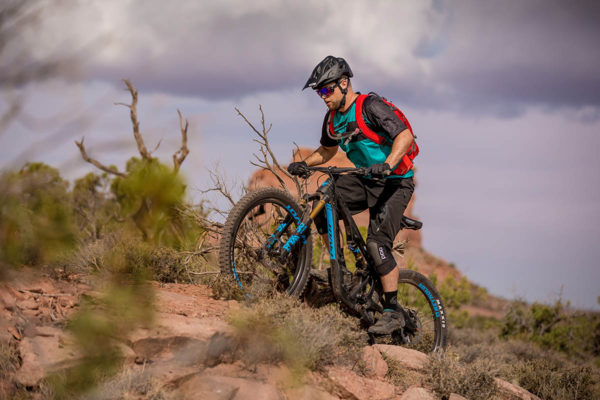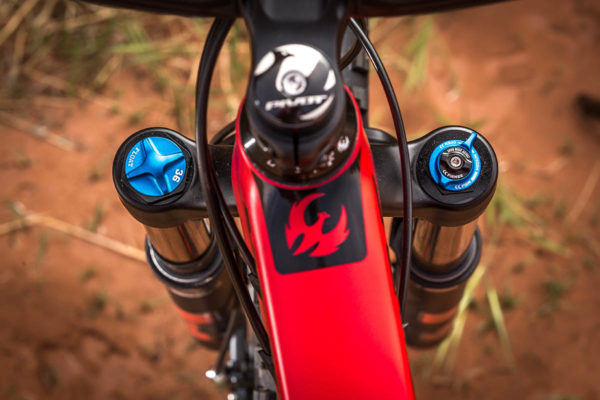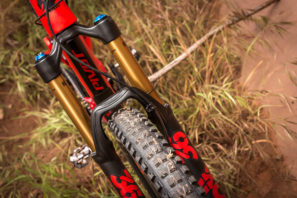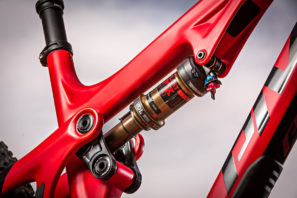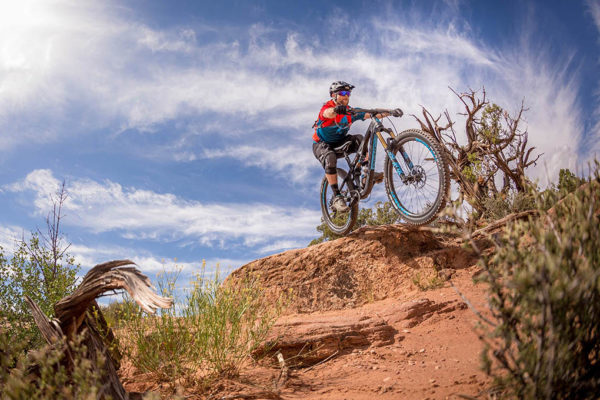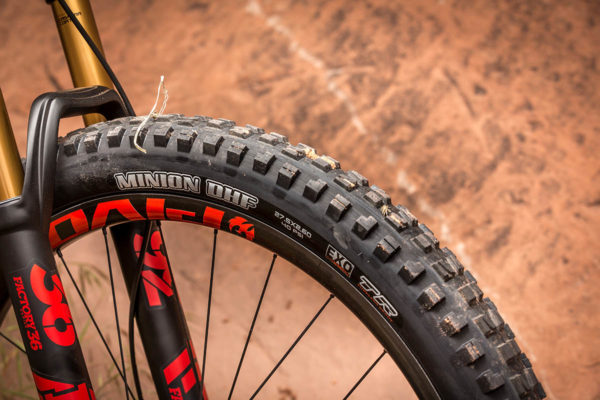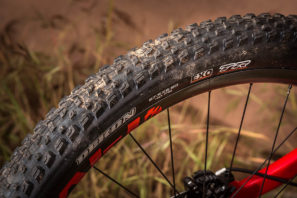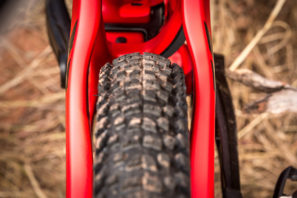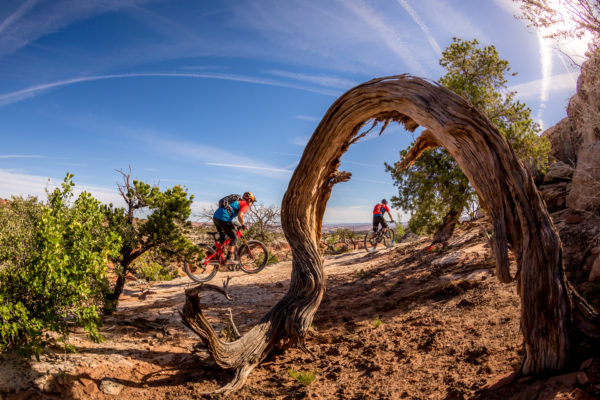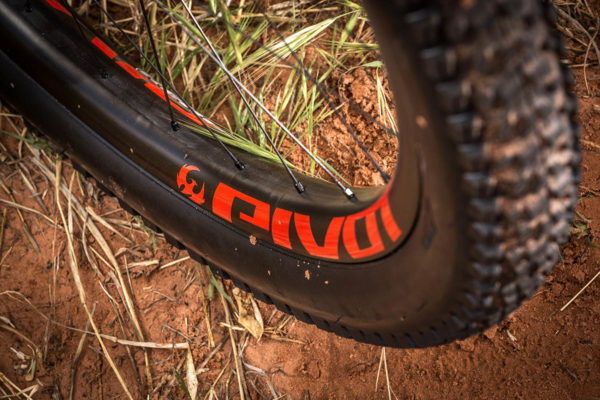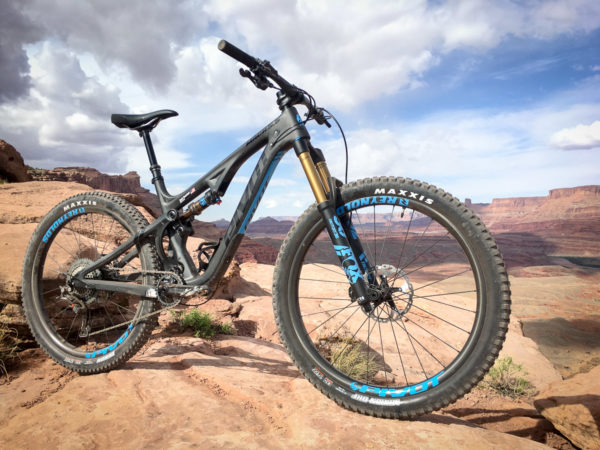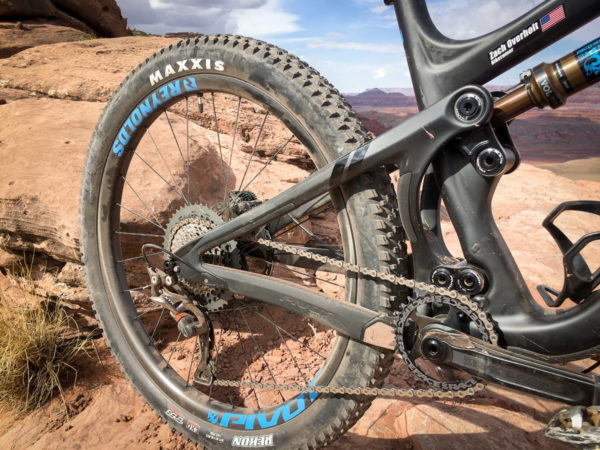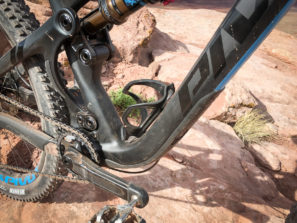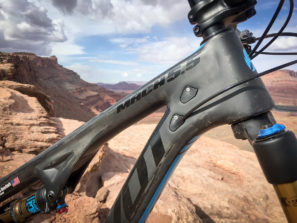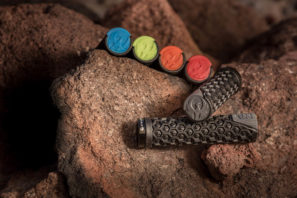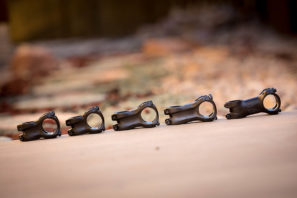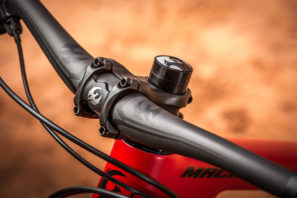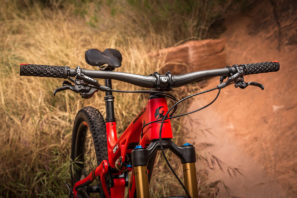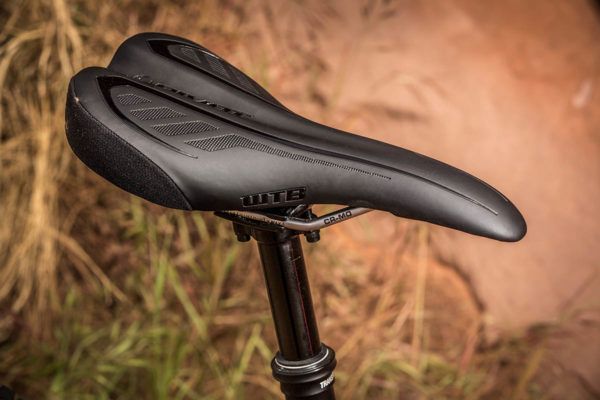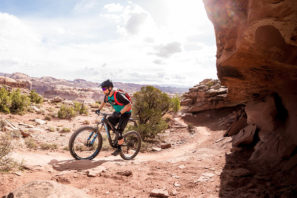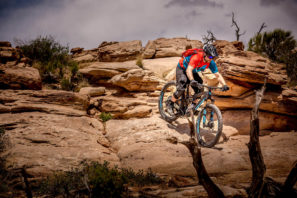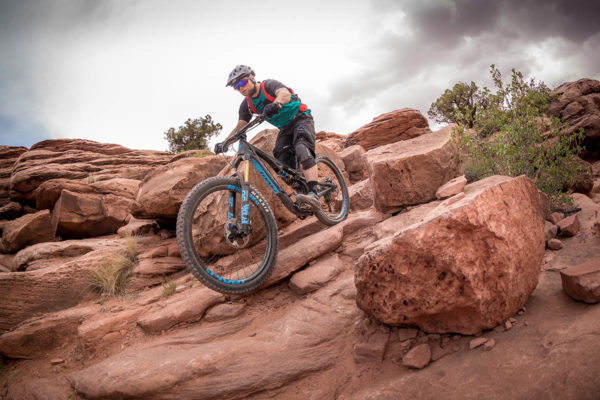Moab has always been one of those must-ride destinations. If you haven’t already been, then you have plans to go, and if you don’t have plans you at least want to make it there some day. Recently, it seems even more attractive thanks to the addition of purpose built mountain bike trails that combine classic Moab flavor with improved flow, features, and terrain.
That also makes it an ideal place for Pivot Cycles to launch a new bike. Not far from their home in Phoenix, the red rocks and chunky terrain are a natural fit for many Pivot bikes like the Switchblade which was launched here last year. Fast forward a year and we’re back on some of the same trails, only this time with a completely different bike.
Instead of a long travel 29er with the ability to run 27.5+, Pivot is going back to their roots with a new mid-travel bike – the Mach 5.5 Carbon. Along with 140mm of dw-link suspension and a 160mm fork, the Mach 5.5 will hit shop floors with 27.5 x 2.6 Wide Trail tires. Not quite a plus bike, but also not the trail bike of years’ past, Moab proved to be a perfect backdrop for the launch of Pivot’s latest bike…
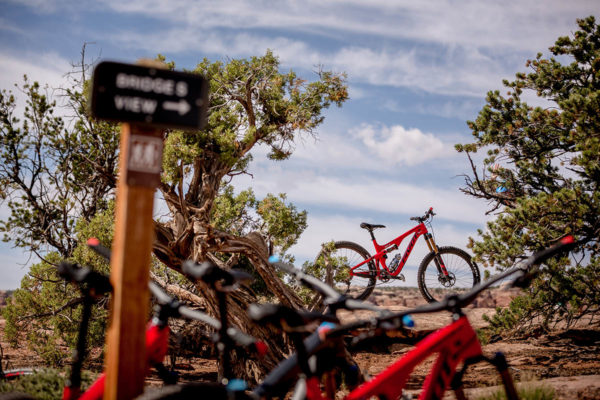
Based on the popularity of the previous Mach 5.7, the trail category is not only big for the industry, but it’s huge for pivot. That means the Mach 5.7’s replacement needed to be good. Really good. Fortunately for Pivot, they seem to be on the right path.
Our short time in Moab with the Mach 5.5 Carbon started with the now iconic ride known as Mag 7. Essentially the combination of 7 different trails, we opted for the full pull which drops you out near the Colorado river after ricocheting through the infamous Portal trail. A ride that will test both your body and your equipment, the day was spent sorting out fit and suspension tunes as we familiarized ourselves with the intricacies of the Mach 5.5.
From the start, Mag 7 features an impressive variety of riding conditions. Everything from long pedaly flat sections, flowy near pump track sections of slick rock, lengthy climbs to the top of the rim, challenging power moves, to puckering downhills spotted with dashes of terrifying exposure. Because of the vastly different trails, ideally you want a bike that is pedal friendly for the majority of the time that you’re traversing along the slickrock, but also a bike that is ready at a moment’s notices to chuck down a rocky chute when you aren’t quite sure what’s on the other side.
Right off the bat, the Mach 5.5 seemed to pedal with familiar dw-link efficiency. Pivot’s founder Chris Cocalis mentioned that the anti-squat curves have changed slightly over the years now using medium shock tunes with a bit less anti-squat, but the bikes still pedal and climb without excess movement in the suspension. That isn’t to say that the suspension didn’t need any tuning though. I started off the day switching back and forth between the Open and the Medium settings on the Float Factory DPS shock. I found Open to not offer quite enough mid stroke support, while Medium was too firm – but both of those settings were with the adjustment dial on 1. After getting some advice from both Pivot and Fox, I switched the dial to the 3 position and settled on Open 3 which seemed like the best balance of mid-stroke support, small bump compliance, and control through hard impacts. Combined with the ability to change out the volume spacers in the Float DPS EVOL air cans, you have an incredibly adjustable suspension system which is great for dialing in the ride for riders of all sizes and riding styles, but it will probably require a little more tuning effort than just setting sag and heading off for a ride.
Similar adjustability is offered out of the front fork with the MY18 Fox Factory 36 offering volume changes for the EVOL air spring with tuning spacers as well as the usual high and low speed compression and low speed rebound adjustments. The fork seemed to require less tuning to get it to where I wanted it, but it could be that it was just set up better for me personally from the start.
By the end of the two days, the suspension felt dialed and my confidence level rose rapidly as I became more acquainted with the bike. That is clearly visible if you go by my personal numbers on Strava, with PRs on nearly every section of Captain Ahab on our second ride with the bike. Granted, I haven’t ridden the trail that many times, but even after riding it last year on the Switchblade, the Mach 5.5. just seemed a little more agile and more willing to pull up for quick, unanticipated drops and techy rock sections.
It’s worth noting that the last time I rode Ahab I was on 27.5+ tires, and there is a noticeable difference between the performance of the plus tires and the 2.6” Wide Trail tires on the 5.5. Mostly, the Wide Trails just felt more stable when pushed hard and less prone to uncontrolled movement on hard landings. However, the plus tires definitely had more grip on the sandy or slickrock sections of trail. With that said, I think Wide Trail will be a better option for the majority of the riding public. They offer more traction and stability than previous trail tires, but as mentioned are still able to be pushed hard without as much tire roll or rim strikes as plus. Will plus be phased out in favor of Wide Trail? It’s hard to say. I think beginner and intermediate riders will still favor the increased traction and stability the plus tires offer which is an almost instant boost to a rider’s confidence level. But the decision to stick with 27.5 x 2.6” tires means that Pivot is able to offer some of that increased confidence, while still allowing riders to move to smaller tires without effecting the ride since the tire heights are similar.
Fitted with a Maxxis Rekon 2.6” in the rear and a Minion DHF in the front, the combination seemed like a perfect choice for Moab’s mix of loose and hard surfaces. Only while cornering hard on the loosest terrain did I ever notice the tires want to push which was probably more a personal handling mistake than the tires. We weren’t completely flat free in our large group, but flats were limited to just a few which could linked to poor line choices and hard rock strikes. I started out with 25psi in the rear tire and about 18psi in the front, eventually letting a bit of air out of the rear to get it closer to 22psi which seemed like the right amount, letting me ride both days flat free.
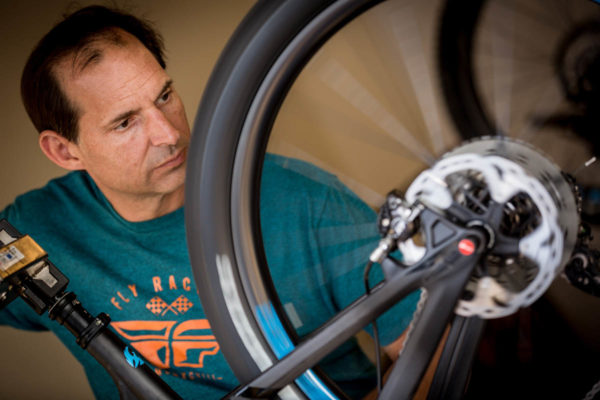
My bike was also equipped with the custom Reynolds carbon wheels with a 36mm internal width. That width was purposely chosen by Pivot to perfectly match the profile of the Maxxis Wide Trail tires. The bikes without the carbon wheels were running DT Swiss aluminum rims with a 35mm internal, but based on the ride of the Reynolds wheels, they are an upgrade that seem to be worth the price ($1,300 for Pro builds, stock on Team builds). Not only did they have a great ride quality that wasn’t overly stiff, they also seemed to take a few solid rock strikes in stride without much more than a scratch.
At 5’8” and with a 690mm top of saddle to center of BB measurement, I was on the medium frame which comes stock with a 125mm Fox Transfer dropper post. I had a more than an inch of exposed seat post below the collar on the dropper, which according to Pivot is probably enough room for me to run the 150mm version of a KS LEV Integra post, but not enough room to run a 150mm Fox Transfer since the part of the post inside the seat tube is longer and would likely bottom out in the frame. It’s a moot point though as the 125mm dropper seems to be plenty for a trail bike, and gave me plenty of room for seatpost height adjustment. The Fox post is also a great dropper with smooth actuation, infinite travel adjust, and a thumb lever that is well thought out for easy access.
I was on a Pro XTR/XT 1x build with an aluminum Aeffect SL Race Face crank. That meant it was a Shimano XTR/XT 1x drivetrain with XT M8000 11-46t cassette and a Race Face 30t chainring which seemed adequate for the climbing in Moab.
Naturally, the Mach 5.5 was also fitted with the Pivot Phoenix Component System which in this case includes a 760mm carbon bar with a 35mm clamp, and a matching forged aluminum stem. The bars take advantage of the WTB Padloc system which notches the ends of the bars to keep them from rotating, but more importantly it allows them to place a large pad of soft rubber at the point where your palm places the most pressure on the bar. Pivot’s stock grip is a 32.5mm diameter outer with a honeycomb structure over the 30mm inner, but I swapped out the grips in favor of WTB’s 30mm Padloc grips due to my preference for mid-thickness grip. Honestly, the WTB 30mm grips are a little hard and I’d like to see Pivot make a 30mm outer diameter with a 28mm inner diameter which seems like it would be a great combination of thickness and comfort.
The last part of the equation is the Phoenix WTB Vigo team saddle which was comfortable right away and disappeared from thought as a good saddle should. Cocalis points out that their saddles no matter what the build level include the same cover, padding, and base, with the only change being the material of the rails.
As first impressions go, the Mach 5.5 Carbon seems to be off to a great start. Jumping on any new bike and immediately riding technical trails can be always be a bit of a learning curve, but the Pivot seemed eager from the start to chuck itself into technical situations while safely guiding me out the other side. Relatively easy to manual or lift the front end, that trait was not overlooked on the hundreds of small rock moves needed to ride any of these trails fairly quickly. Yet, as a good trail bike should, the 5.5 climbs very well once you have the suspension dialed in. It may seem a little odd to mix 140mm of rear travel with 160mm in the front, but the 5.5 never felt out of balance, some how feeling both like a shorter travel and a longer travel bike at different times. If the Mach 5.7 was the benchmark, the 5.5 should have no problem being the new standard.
